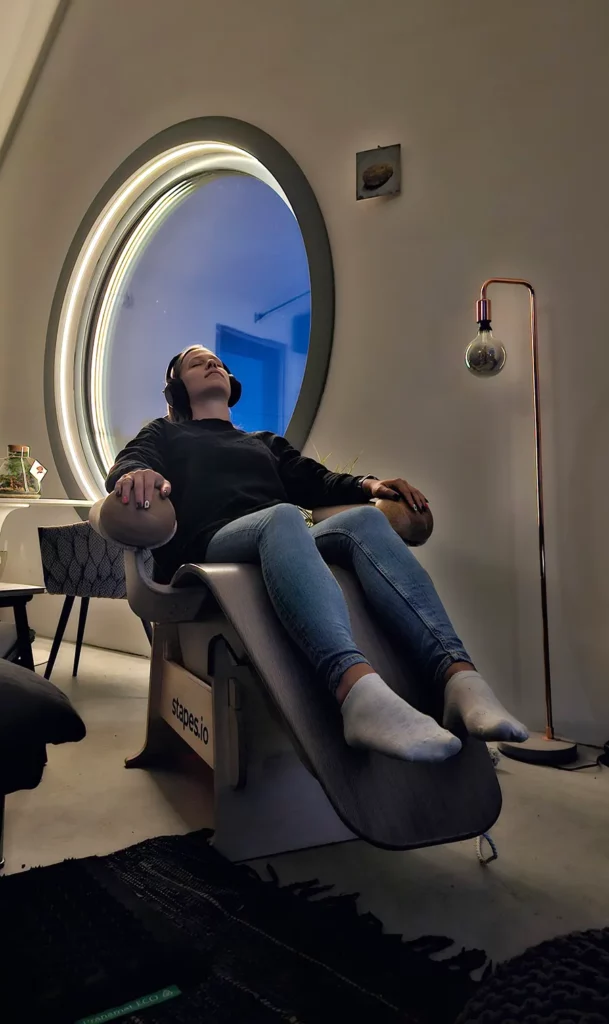When Jānis Siders returned from a profoundly touching ten-day-long silent meditation retreat, he told many people about it, recommending the experience. To his surprise, most of them thought spending ten days in silence was a mad idea, but this got him thinking. Could Jānis find a way to help people reach a similar meditative state faster and more effectively? This led to the founding of Stapes, the company behind an immersive vibroacoustic bed designed to deliver a multi-sensory relaxation experience guided by sound.
Stapes is currently exploring several applications, such as stress relief for employees in an office environment or for patients and visitors in a hospital setting. While many businesses are working on stress relief apps and soundscapes delivered via headphones, Stapes stands out with its focus on the sensory experience for the entire body. The vibroacoustic bed acts like a loudspeaker with layers of added value.

Paternity leave as a platform for experiments
For years, the founder, Jānis, worked in IT system development. During his paternity leave, he found that he had several hours a day to dedicate to doing something he’d love to do if he didn’t have to earn money. It was then that he started looking into 3D modeling and other ways of bringing his ideas to life faster.
At a 3D printing hackathon, Jānis and his team worked on a device that would help children learn musical notes. They built an app with which the user would press a note, the phone would play it out loud, another fixture would allow them to feel the note by placing their hand on a special membrane, and a third would allow them to see it in the form of a drawing made by a laser. The idea was to enable children to learn each of the musical notes via different senses and media. They won the hackathon.

Through this experience, Jānis realized the vast array of ways in which we can represent the information coming from any single source. When it comes to sound, we hear it but don’t often pay attention to the vibrations it produces.
Drawing from previous work experience
Another of Jānis’s experimental pastimes involved video. “I figured we all have the same number of hours on our hands. If I don’t want to work through the night, how can I learn faster and more efficiently to learn more during my time?” he shares. He would watch videos at varying speeds to try to establish whether the playback speed changed how he perceived the information in the video.
Jānis discovered that “there was one speed at which I could perceive what was being said, and it wasn’t when I was tensely focused but rather when I was relaxed and letting the information come to me.”
At that point, he recalled his experience in IT: “In systems, when you get a bottleneck, you create channels and increase the data processing capacity, so I wondered if people might have a way to distribute energy and perceive it through a range of senses, thus increasing the speed of perception?” The answer lies in sensory integration – how we process, integrate, and organize the sensory information we receive from our bodies and environments.
From first prototypes to sophisticated products
Jānis decided to focus on sound, aiming to find ways to deliver it to the body in as real a time as possible with as few abstractions as possible. Sound travels slowly through the air. We are quicker to sense with our eyes and touch.
With this new knowledge, Jānis settled on trying to deliver the experience through the bones. The first prototype of the new device was two hand bowls and, later, a veneer board to lie down on, equipped with speakers. Since then, it has grown to become a much more sophisticated vibroacoustic bed, which one lies down on to feel and listen to the sound. Virtual reality goggles can add another sensory layer.
En route to unlocking the full potential of sound
At trials, people have compared the experience to a float tank. Your mind has nothing to process, so the inner voice switches itself off, and you flow along with the sound. Others have noted how feeling the sound in your body allows picking up on specific frequencies.
With ongoing research and advances in artificial intelligence, Jānis hopes that Stapes will eventually produce sounds based on people’s pulse, echocardiograms, and other bodily readings so that the experience is completely individualized.
Additionally, he notes that research shows the significance of sound to psychedelic therapies. “Our goal is for the sound alone to become so effective that you don’t need any additional substances,” he shares.







